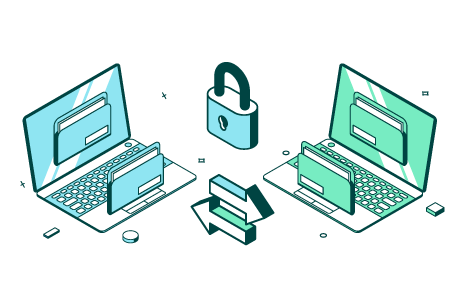What Is Identity and Access Management (IAM)?

Identity and Access Management is an IT security safeguard that focuses on managing digital identities and user access to data, systems, and resources within an organization. IAM security includes the policies, programs, and technologies that reduce identity-related access risks within a business.
How Identity and Access Management Works
IAM systems accomplish an essential part of IT security by providing the capability to create and manage user accounts, roles, and access rights for individual users in an organization. These systems typically incorporate user provisioning, password management, policy management, access governance, and identity repositories in an often complex design.
IAM: An Essential Piece of Risks Management
According to the 2021 Identity and Access Management Report, 90 percent of organizations confirm that IAM solutions are important in their risk management posture. This confirmation of IAM as a strategic imperative means it should be viewed from a cross-functional perspective of stakeholders—from business leaders, IT and security teams, customers, auditors, employees, contractors and non-employees, vendors and partners.
A solid approach to IAM enables organizations to mitigate risks, improve compliance, and increase efficiencies across the enterprise. That’s why overseeing appropriate access through the right IAM framework goes a long way towards bolstering risk management within the organization and closing the gap on overall IAM risk.
Identity Management vs. Access Management
What are the individual components of IAM and how do they work together to reduce security risks?
Identity Management
Access Management
Types of Digital Authentications
Once users have their identity ingrained in the system and have been given the access necessary to do their job, they’re still going to have to continuously prove their identity to access sensitive information if they're working remotely. The following is a series of digital authentication methods that can be used for doing so.
One-time Password Generation
This function relies on source algorithms to deliver a single use, time-limited, unique password via mobile application. When a user is asked to authenticate, they use the app to generate a one-time password and enter that value when prompted.
Push Notifications
These are sent to users’ mobile devices. A notification displays the user profile that’s attempting to sign in, information about the system that’s being signed into, and a prompt to confirm or deny whether the sign-in attempt is legitimate. If the user confirms the attempt is a legitimate authentication, a message is returned to the authentication manager and the user is allowed to sign in. Denying the attempt means the authentication fails, and an alert can be sent to the administrator.
Biometric Scanning
This is among the most modern types of digital authentications, and requires the collection of biometrics such as fingerprints, voice, or even DNA. The most common form of which is fingerprint scanning prompted in the form of a push notification.
USB Authenticators
USB authentication involves the use of USB keys that plug into your computer and display a totally unique identity that is then assigned to you. These keys almost always connect to online servers to carry out this verification process.
The Benefits of Identity and Access Management

Increased Operational Efficiency
IAM empowers organizations to do more with less.
Many security teams today are understaffed and overextended, but are expected to manage and protect increasing numbers of devices, data, users, and systems. By leveraging IAM programs to automate and streamline access management, organizations can boost operational efficiencies.
One study found that 56 percent of organizations view operational efficiency as an IAM program driver.
IAM empowers organizations to do more with less.
Many security teams today are understaffed and overextended, but are expected to manage and protect increasing numbers of devices, data, users, and systems. By leveraging IAM programs to automate and streamline access management, organizations can boost operational efficiencies.
One study found that 56 percent of organizations view operational efficiency as an IAM program driver.

Enhanced Security and Mitigate Risks
A recent study found that 87 percent of organizations indicate identity and access management programs are very or extremely important to their cybersecurity and risk management posture, while 76 percent of organizations that use identity and access management solutions saw a reduction of unauthorized access incidents.
Ensuring that users have only the necessary level of access required to do their job goes a long way towards bolstering an organization’s risk management and security posture.
A recent study found that 87 percent of organizations indicate identity and access management programs are very or extremely important to their cybersecurity and risk management posture, while 76 percent of organizations that use identity and access management solutions saw a reduction of unauthorized access incidents.
Ensuring that users have only the necessary level of access required to do their job goes a long way towards bolstering an organization’s risk management and security posture.

Improve Compliance
As regulatory compliance and industry mandates like SOX, HIPAA, and GDPR have become increasingly stringent and more complex in recent years, organizations face more auditing, compliance reviews, and mandatory reporting.
IAM solutions that automate data collection, reporting, and access reviews enable companies to limit access to only those individuals who need it and stay more compliant to industry standards.
By leveraging strategic IAM security policies, organizations can ensure data is strictly controlled and prove they are taking proactive steps to meet ongoing compliance requirements.
As regulatory compliance and industry mandates like SOX, HIPAA, and GDPR have become increasingly stringent and more complex in recent years, organizations face more auditing, compliance reviews, and mandatory reporting.
IAM solutions that automate data collection, reporting, and access reviews enable companies to limit access to only those individuals who need it and stay more compliant to industry standards.
By leveraging strategic IAM security policies, organizations can ensure data is strictly controlled and prove they are taking proactive steps to meet ongoing compliance requirements.
Identity and Access Management Tools
Identity and Access Management Solutions from Fortra
Organizations today typically use leading IAM security solutions through best of breed solution partners—from identity governance solutions to privileged access management offered either on premises, on cloud or through hybrid models. These tools make up the technology solutions that support the overall IAM security framework and are essential in establishing a solid foundation for identity and access management.
Secure Your System with Fortra's Identity and Access Management Solutions Today
Learn how Fortra's IAM solutions can help today.